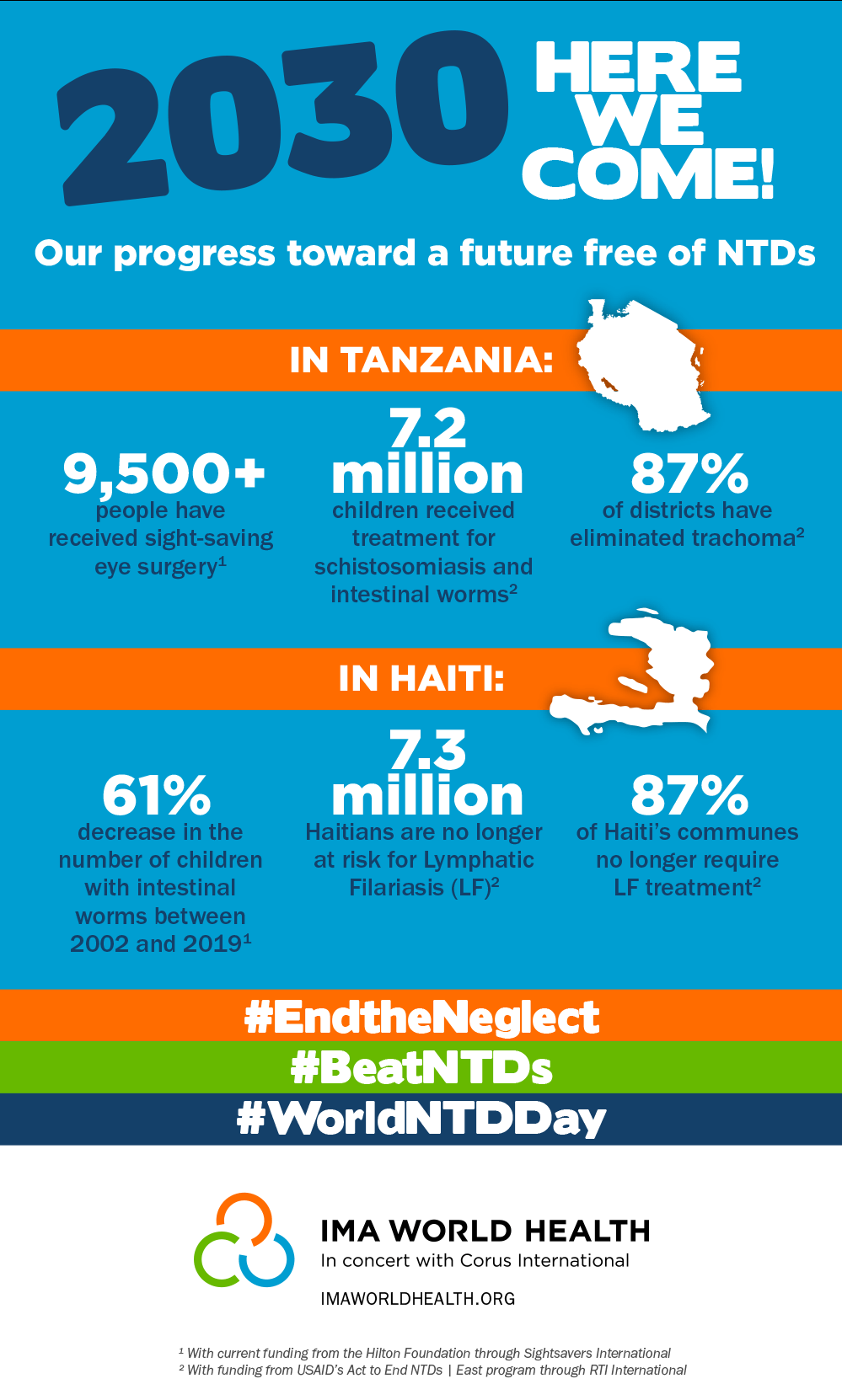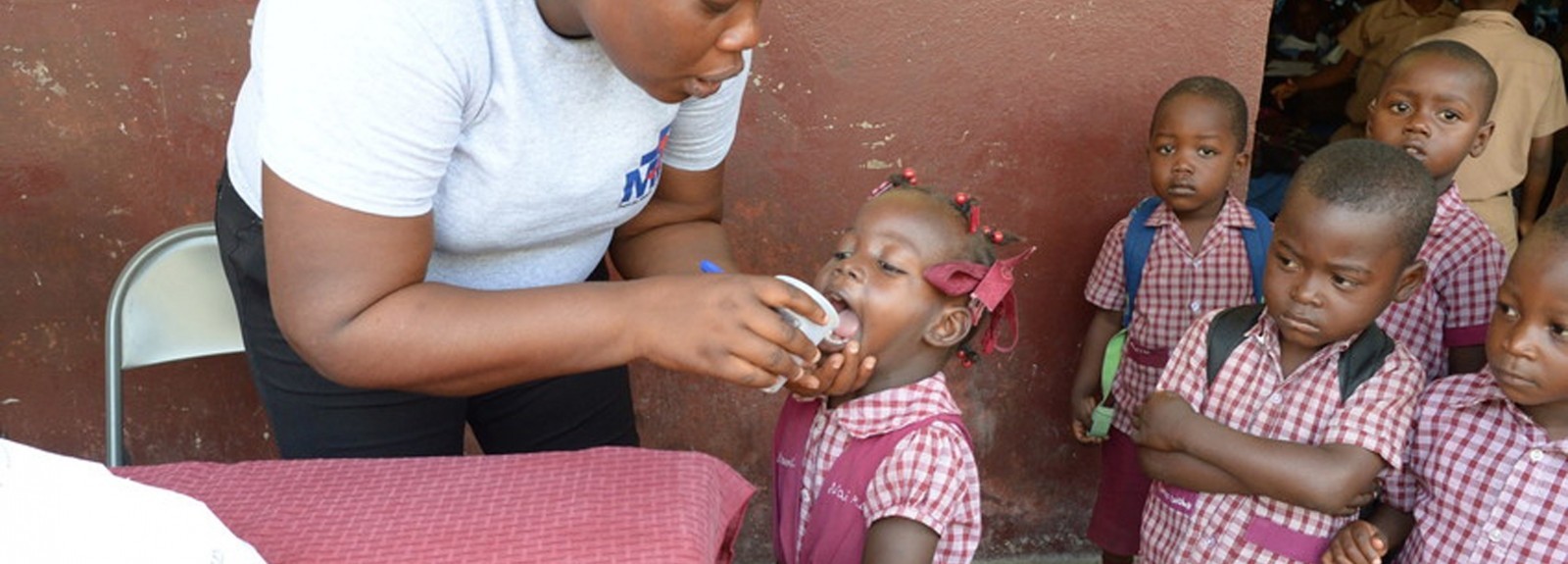In honor of World NTD Day and the launch of the World Health Organization's new Neglected Tropical Disease Road Map, IMA World Health is pausing to acknowledge the hard work and partnership that has helped to bring the global goals for controlling and eliminating NTDs ever closer. As each milestone is achieved, there is cause for celebration: soon, hundreds of millions of people will be able to live healthier and more prosperous lives, free of NTDs.

IMA’s work and progress
IMA has supported NTD control programs for more than two decades, often overcoming significant challenges — including the current global coronavirus pandemic — to stay the course. But partnerships between donors, governments, implementers and communities are strong, and IMA is confident the collaboration that has carried us this far will keep us on track to meet the new 2030 control and elimination goals.
Haiti: 87% of the way to LF elimination
Lymphatic filariasis and soil transmitted helminths are the two preventive chemotherapy NTDs endemic in Haiti. In 2001, in line with WHO's global LF elimination goals, the Haiti NTD Control Program set a goal to eliminate LF and control STH by 2020. Accomplishing this would require preventive chemotherapy, in which a dose of medicine is administered once or twice per year across the target population, over the course of several years.
When these efforts began, approximately 11 million people required preventive treatment for LF across all 140 communes. By 2012, the program reached 100% geographic coverage for mass drug administration — a massive feat of coordination and partnership. Since then, Haiti has made incredible strides toward its goals and has seen a significant decline in LF and STH prevalence.
Case in point: by the end of 2020, 122 out of 140 communes achieved the criteria for stopping treatment — and 87% achievement. Now 7,334,355 Haitians are no longer at risk for LF. Just 18 communes (13%) remain endemic. As work continues, the end is clearly in sight.
Additionally, STH prevalence among school-age children has significantly decreased thanks to program efforts, from 37% in 2002 to 14.5% in 2019 — resulting in better health, nutrition, school attendance and achievement for hundreds of thousands of children.
The Haiti NTD Control Program’s accomplishments have been made possible by funding and technical support from the U.S. Agency for International Development through the previous ENVISION project and current Act to End NTDs | East program, with IMA World Health as lead implementing partner in Haiti, RTI International as the prime award recipient, as well as the University of Notre Dame, The Carter Center, the U.S. Centers for Disease Control and Prevention, Task Force for Global Health, the Pan-American Health Organization and GlaxoSmithKline.
Tanzania: 5 diseases in decline
Tanzania is among the countries endemic with the five preventive chemotherapy NTDs: onchocerciasis, LF, trachoma, schistosomiasis and STH. Among these five diseases, three are on the path toward elimination globally: onchocerciasis, LF and trachoma. The two others, schistosomiasis and STH, are on a path toward disease control.
IMA supports control and elimination efforts in Tanzania with mass drug administration through the USAID Act to End NTDs | East program, facilitating mass drug administration annually in 19 regions and 134 districts across the country. With funding from the Hilton Foundation, IMA also facilitates sight-saving surgeries for people whose vision has been affected by trachoma infection.
Chasing elimination goals
- Lymphatic filariasis: A mapping exercise between 1999-2004 showed that LF was endemic in all of Tanzania’s 120 districts, leaving 50 million people at risk of infection. As of June 2020, Tanzania has been able to stop mass drug administration for LF in 111 districts (93%). This scale-down can be attributed to strong coverage (≥65%) and rigorous disease monitoring by the program in collaboration with U.S. Government investments. Currently, just five districts under Act | East support still require treatment for LF. Elimination mapping and data review will happen in 2021 to determine how much closer we may be to the finish line.
- Onchocerciasis: Of the 28 districts endemic for onchocerciasis, none has achieved the criteria for stopping treatment yet. However, based on WHO guidance, in the last year the Tanzania program began doing mass drug administration for onchocerciasis twice per year in nine districts in order to accelerate outcomes toward elimination, with a goal of achieving it by 2025.
- Trachoma: With funding from USAID, mapping for trachoma was completed in 2014 using the Global Trachoma Mapping Project platform. A total of 71 districts were trachoma endemic. As of June 2020, 65 districts have achieved have met the criteria for stopping MDA — an 87% achievement.
Progress toward control. Controlling SCH and STH continues to be very challenging. However, between IMA's partnership with the SCI Foundation and efforts on the USAID Act to End NTDs | East program, 7.2 million school-aged children (of the 7.6 million targeted) received treatment for STH and SCH in 2020 in 134 districts — a coverage rate of 95%. This means better nutrition, health and school-readiness outcomes for these children and their families.
Sight-saving surgery. IMA also facilitates eye surgery for individuals suffering from complications of trachoma (referred to as trachomatous trichiasis or TT) in endemic regions of Tanzania, under the WHO-endorsed SAFE program. IMA is part of a consortium of implementing partners led by Sightsavers International and in partnership with the Tanzania NTD Control Program. Those affected by TT — a majority of whom are women due to their caregiving responsibilities and repeated exposure to the disease in children — receive a simple surgery on one or both eyes to stop the progression toward blindness. In 2019, IMA’s efforts to conduct case finding, screening and surgical services resulted in nearly 4,000 surgeries. In total, the program has conducted 9,560 surgeries. Though the COVID-19 pandemic has paused program activities, IMA is committed to resuming full the pace as soon as possible.
With these significant achievements, IMA — with collaboration and support from donors, partners and communities — is proud to be on track with the WHO NTD Road Map, in pursuit of health, healing and well-being for all in world free of NTDs.


